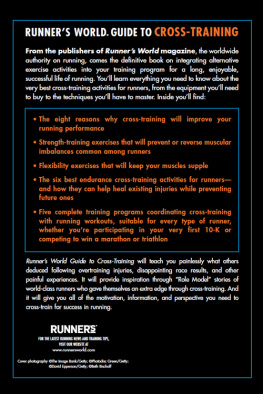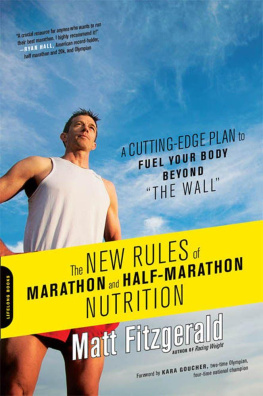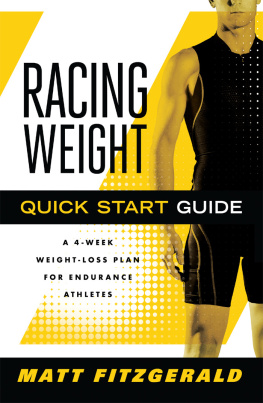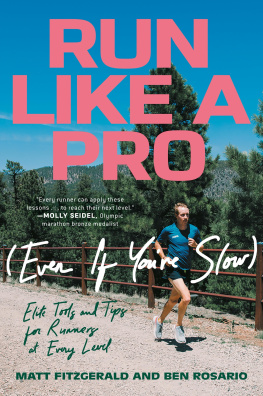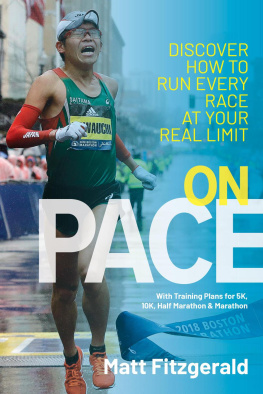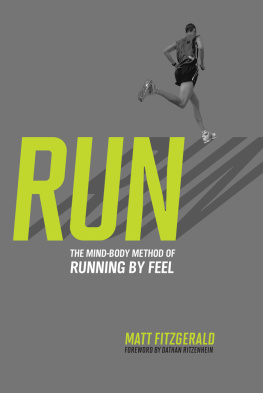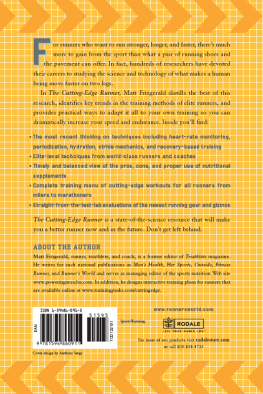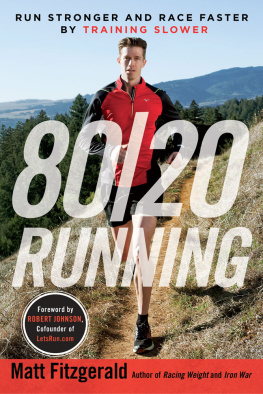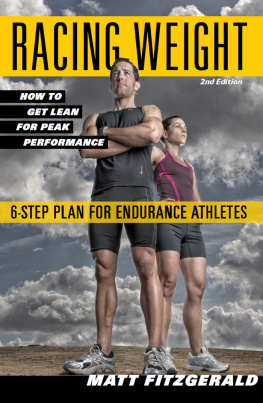Matt Fitzgerald - Runners World Guide to Cross-Training
Here you can read online Matt Fitzgerald - Runners World Guide to Cross-Training full text of the book (entire story) in english for free. Download pdf and epub, get meaning, cover and reviews about this ebook. year: 2012, publisher: Potter/Ten Speed/Harmony/Rodale, genre: Romance novel. Description of the work, (preface) as well as reviews are available. Best literature library LitArk.com created for fans of good reading and offers a wide selection of genres:
Romance novel
Science fiction
Adventure
Detective
Science
History
Home and family
Prose
Art
Politics
Computer
Non-fiction
Religion
Business
Children
Humor
Choose a favorite category and find really read worthwhile books. Enjoy immersion in the world of imagination, feel the emotions of the characters or learn something new for yourself, make an fascinating discovery.
- Book:Runners World Guide to Cross-Training
- Author:
- Publisher:Potter/Ten Speed/Harmony/Rodale
- Genre:
- Year:2012
- Rating:5 / 5
- Favourites:Add to favourites
- Your mark:
- 100
- 1
- 2
- 3
- 4
- 5
Runners World Guide to Cross-Training: summary, description and annotation
We offer to read an annotation, description, summary or preface (depends on what the author of the book "Runners World Guide to Cross-Training" wrote himself). If you haven't found the necessary information about the book — write in the comments, we will try to find it.
Runners World Guide to Cross-Training — read online for free the complete book (whole text) full work
Below is the text of the book, divided by pages. System saving the place of the last page read, allows you to conveniently read the book "Runners World Guide to Cross-Training" online for free, without having to search again every time where you left off. Put a bookmark, and you can go to the page where you finished reading at any time.
Font size:
Interval:
Bookmark:


MATT FITZGERALD

I would like to express my deepest thanks to the many runners, coaches, and others whose various contributions made this book possible and better: Richard Benyo, Amby Burfoot, Leah Flickinger, Josh Fitzgerald, Jeff Galloway, Christina Gandolfo, Dan Gilbert, Joe Henderson, Libbie Hickman, Deena Kastor, Jeremy Katz, Meb Keflezighi, Khalid Khannouchi, David Krummenacker, Kathryn LeSage, Bob Larsen, Cathy OBrien, Andrea Pedolsky, Steve Plasencia, Robert Portman, Dathan Ritzenhein, Lou Schuler, Ryan Shay, and Joe Vigil.
This book grew out of my own experience as an athlete. I had been running competitively for 15 years when I got a notion to branch into triathlons. In doing so, I expected that my running background would give me a solid foundation for progress in swimming and cycling, and this proved to be the case. But to my astonishment, I also found that multidisciplinary training made me a better runner. I gained speed, efficiency, and endurance on foot despite the fact that I was running less, and I also suffered fewer injuries and experienced greater overall motivation for training.
After making this happy discovery, I began to experiment with various ways of using cross-training to enhance my running apart from my interest in triathlons. Experimentation was indeed necessary, because my search for solid cross-training principles and methods among the established running experts turned up surprisingly little. Through trial and error, I was able to collect a reliable set of methods, which I then began prescribing to the runners I coached, who achieved similar benefits. The next step was to take my cross-training approach to the broader community of runners.
By no means is the guidance in this book based solely on my experience as a runner and coach, however. I didnt invent flexibility training, strength training, or any of the forms of nonimpact endurance training discussed in the following pages. Nor did I create any of the established principles and methods of training for distance-running events. All Ive done is find some reliable ways of putting together running and these complementary forms of training. And Im not the only person to have done even this much. In writing this book, I benefited from the input of other coaches and elite runners who represent the vanguard of the cross-training approach to competitive running.
The basic philosophy that these runners and coaches share with me is simple: Runners cannot succeed by only running. If you want to be as healthy, fit, and fulfilled as you can be as a runner, your training should involve not only running but also flexibility training, strength training, and one or more forms of nonimpact endurance training, such as bicycling or deep-water running. In a word (or, technically, four words), you need to cross-train.
Most runners have a basic understanding that they should cross-train, yet they nevertheless tend to cross-train erratically, unsystematically, and without clear purpose, if at all. The problem is not in the runners themselves; it is in the resources runners rely on for training information and guidance. The coaches and running experts from whom runners learn how to train, directly and indirectly, have tended not to make a strong enough case for cross-training and have treated it as a peripheral rather than central component of training. Worse, they often contradict one another in the cross-training recommendations they give.
What runners need in order to cross-train effectively is a complete and authoritative guide to cross-training. That is what I have set out to provide in this book. My aim is to give you all of the motivation, information, and perspective you need to cross-train for success in running, whether success for you means finishing a 10-K or winning a marathon.
There is no single right way to cross-train for running. As with your running itself, how you should cross-train depends on several factors, including your goals, personal preferences, and past and present injuries, as well as how your body responds to various types of training. Nevertheless, every runner needs to cross-train consistently, systematically, and purposefully, using proven methods that apply universally to all runners. The first step is to fundamentally change the way you view your training. Stop seeing cross-training modalities as the icing on the cake of training. Start viewing them as the very meat of training, along with running itself. How do you make this shift? It happens quite naturally when you get a clear understanding of the full range of benefits of cross-training (which happens to be the subject of ). The next step is to give proper cross-training a legitimate try. Once you have experienced the benefits for yourself, theres no turning back. Thats how we runners work.
Warmed up? Good. Lets make strides.
CROSS-TRAINING
I F YOU ASK 10 OTHER RUNNERS to name a benefit of cross-training, at least 8 of them will mention injury prevention. But although injury prevention is by far the most widely recognized benefit of cross-training among runners, its hardly the only one. Runners can also use cross-training to rehabilitate injuries, improve fitness, promote recovery, enhance motivation, rejuvenate the mind and body during breaks from formal training, enjoy competing in other endurance sports, and even stay fit through pregnancy. Related to the benefit of injury prevention, cross-training can also prolong your running career.
The good news is that you dont have to do eight different kinds of cross-training to get these eight distinct benefits (seven if youre male). You can enjoy them all by supplementing your running with a little strength training, flexibility training, and endurance cross-training (for instance, bicycling or swimming). Each of these three forms of cross-training has its own relationship to the benefits Ive just mentioned, but theres plenty of overlap.
Strength training is most useful for injury prevention and rehabilitation and improving running fitness. Flexibility training helps primarily with injury prevention and rehabilitation and recovery. Alternative forms of cardiovascular conditioning are useful in relation to all eight benefits, although much depends on the specific form of exercise. For example, bicycling is generally more useful than swimming as a means of improving running fitness, since it increases leg strength. But it may be less useful than swimming for certain cases of injury rehabilitation.
As you get deeper into the book, Ill say more about the specific effects of these three forms of cross-training and show you how to incorporate each into your overall training program. Here, Ill simply sell you on the benefits. We runners arent lazy, but we are practical. Once we believe something will improve our running, well make the effort to include it in our programs. Until then, we wont. We cant afford to waste our time and energy on workouts that are more hype than help. Heres my case.
Overuse injuries are the curse of the running life, a never-ending epidemic among pavement (and trail) pounders everywhere. Studies suggest that as many as 50 percent of competitive runners miss at least a few days of training each year because of injuries, and most of those injuries are from the chronic grind of training. (Acute injuries, from slips and stumbles, are much less common.) Indeed, youd be hard-pressed to find a runner of more than a few years experience who hasnt come up lame with shin splints, runners knee, plantar fasciitis, Achilles tendinitis, or another common running-related overuse condition. If I were a betting man, Id wager you have had at least one of these injuries at least once.
Next pageFont size:
Interval:
Bookmark:
Similar books «Runners World Guide to Cross-Training»
Look at similar books to Runners World Guide to Cross-Training. We have selected literature similar in name and meaning in the hope of providing readers with more options to find new, interesting, not yet read works.
Discussion, reviews of the book Runners World Guide to Cross-Training and just readers' own opinions. Leave your comments, write what you think about the work, its meaning or the main characters. Specify what exactly you liked and what you didn't like, and why you think so.

